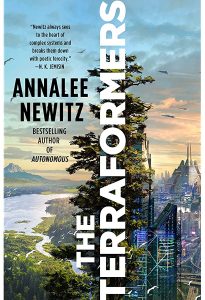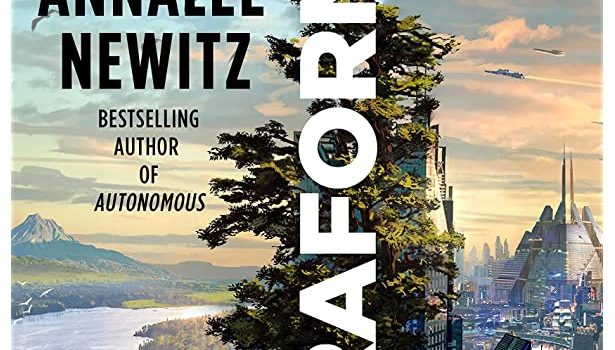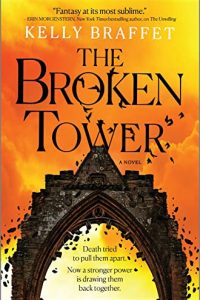Gary K. Wolfe Reviews The Terraformers by Annalee Newitz
 The Terraformers, Annalee Newitz (Tor 978-1-250-22801-7, 352pp, $27.99, hc) January 2023.
The Terraformers, Annalee Newitz (Tor 978-1-250-22801-7, 352pp, $27.99, hc) January 2023.
The very title of Annalee Newitz’s The Terraformers suggests ambition, and not only the hubris involved in setting out to remodel whole planets as though they were unfinished basements. The concept has been prominent in SF for decades–the term itself dates back to an 80-year-old Jack Williamson story – and Newitz is well aware that they’re revisiting territory that has already produced a few classics, most prominently Kim Stanley Robinson’s Mars trilogy of the 1990s. So it shouldn’t be surprising that Newitz’s canvas is huge – a distant planet called Sask-E, thousands of light-years from Earth and several millennia after the end of the Anthropocene, a time scale that measures in centuries, and characters, both human and nonhuman, who live for centuries. But what might surprise readers expecting an abstract historical epic in the Foundation tradition – with which it shares a structure of novellas knitted together – is that the first of Newitz’s tales features a rather endearing moose romance, and that the last involves a cat and a train who fall in love. In other words, there’s a refreshingly playful sensibility at work here, while at the same time Newitz offers a deeply serious critique of capitalism as a mechanism for environmental management. The villains, presented in a pretty unvarnished manner, are not galactic empires or scary aliens, but a terror much closer to home: basically, real-estate developers.
Terraforming tales often follow the familiar template of planetary colonization stories: settlers followed by developers followed by some sort of crisis that, as often as not, results in a movement for independence. While Newitz touches these bases, they rethink each stage of the process in ways that are both wildly imaginative and yet sharply relevant to contemporary issues ranging from the nature of personhood to corporate predation to affordable housing shortages. In the first section, ‘‘Settlers’’, we meet Destry, a ranger for the Environmental Rescue Team, an organization which for thousands of years has sought to protect planets, often through collaboration with native life forms. But when Destry dispatches an illegal poacher – an arrogant back-to-nature type described as a ‘‘Pleistocene fetishist’’ – she finds herself called on the carpet by her supervisor Ronnie Drake, who will seem chillingly familiar to anyone who has worked with such a passive-aggressive bureaucrat. Ronnie’s job is to preserve the interests of the huge Verdance Corporation, which wants to develop the whole of Sask-E as a privately held planet by selling plots of land once the planet has been terraformed into a theme-park replica of Pleistocene Earth. The scheme is threatened, though, when Destry and her companion Whistle (a flying moose whose romance with another moose named Midnight provides one of the neater subplots of this section) discover a subterranean colony called Spider, whose settlers arrived prior to Verdance’s acquisition of the planet. As the stakes rise to include the possibility of war and even the deployment of a cataclysmic superweapon, Destry finds herself and her companions thrust into the role of environmental diplomats.
The second section, ‘‘Public Works,’’ is set several centuries later, although Ronnie is still sending out the snarky memos that annoyed Destry. This time, Destry’s former pupil Misha is the target. By now, Sask-E is dotted with cities, and Misha’s assignment is to design a public transit system – though Ronnie and the Verdance Corporation have a very particular idea of how to maximize their own profits, despite the needs of the actual communities. Along with civil engineer Sulfur, an intelligent drone named Rocket, and an assortment of bots and hominins, Misha again draws Ronnie’s ire by choosing to help a small community called Angst. In the final section, ‘‘Gentrification’’, we meet the intelligent self-guided train Scrubjoy, whose growing friendship with a cat named Moose (yes, that’s connected to the earlier moose romance) helps the population of Sask-E – now faced with increasing rents, predatory landlords, and what amounts to a kind of redlining restricting some areas to homo sapiens – to make a discovery that may help the wildly diverse residents find a way to determine their own fate. In the end, The Terraformers presents an optimistic vision not too far removed from Kim Stanley Robinson’s optimism: meaningful actions that might succeed if implemented by functioning communities, but that are anything but inevitable, and that face some pretty steep odds given political and economic realities. While the novel entices with its brilliant and varied cast of human and nonhuman characters (I was particularly taken by Rocket the drone, Scrubjoy the train, and those moose), it also offers a serious and hopeful template that’s a lot closer to home than all those distant light-years and centuries might at first suggest.
Gary K. Wolfe is Emeritus Professor of Humanities at Roosevelt University and a reviewer for Locus magazine since 1991. His reviews have been collected in Soundings (BSFA Award 2006; Hugo nominee), Bearings (Hugo nominee 2011), and Sightings (2011), and his Evaporating Genres: Essays on Fantastic Literature (Wesleyan) received the Locus Award in 2012. Earlier books include The Known and the Unknown: The Iconography of Science Fiction (Eaton Award, 1981), Harlan Ellison: The Edge of Forever (with Ellen Weil, 2002), and David Lindsay (1982). For the Library of America, he edited American Science Fiction: Nine Classic Novels of the 1950s in 2012, with a similar set for the 1960s forthcoming. He has received the Pilgrim Award from the Science Fiction Research Association, the Distinguished Scholarship Award from the International Association for the Fantastic in the Arts, and a Special World Fantasy Award for criticism. His 24-lecture series How Great Science Fiction Works appeared from The Great Courses in 2016. He has received six Hugo nominations, two for his reviews collections and four for The Coode Street Podcast, which he has co-hosted with Jonathan Strahan for more than 300 episodes. He lives in Chicago.
This review and more like it in the January 2023 issue of Locus.
 While you are here, please take a moment to support Locus with a one-time or recurring donation. We rely on reader donations to keep the magazine and site going, and would like to keep the site paywall free, but WE NEED YOUR FINANCIAL SUPPORT to continue quality coverage of the science fiction and fantasy field.
While you are here, please take a moment to support Locus with a one-time or recurring donation. We rely on reader donations to keep the magazine and site going, and would like to keep the site paywall free, but WE NEED YOUR FINANCIAL SUPPORT to continue quality coverage of the science fiction and fantasy field.
©Locus Magazine. Copyrighted material may not be republished without permission of LSFF.







